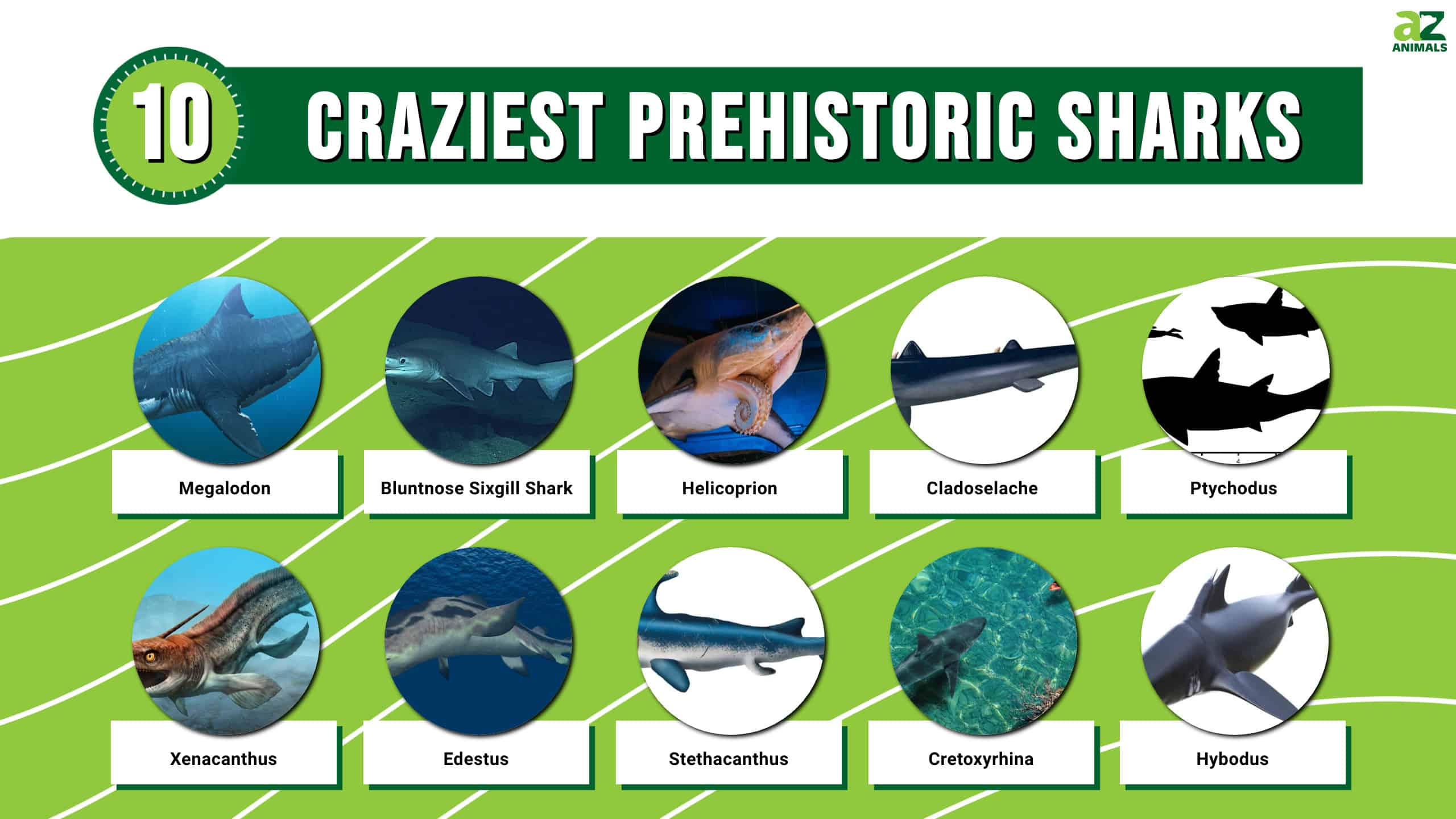
Sharks have lived for more than 400 million years and thousands of species have gone extinct across that time. Today’s sharks are pretty crazy. Just consider that the whale shark can measure up to 60 feet in length yet survives nearly entirely on tiny plankton! Or look at hammerhead sharks that have 360-degree vision thanks to their unique head shape!
Yet, prehistoric sharks had even crazier adaptations. In the article below we’ll dive into 10 of the crazies prehistoric sharks. From anvil heads to “chainsaw mouths,” you’ll discover some prehistoric sharks that are mind-blowing!
10. Hybodus

Hybodus lived for more than 200 million years!
©Herschel Hoffmeyer/Shutterstock.com
Hybodus lived about 303.4 million to 66 million years ago and is possibly one of the longest-living prehistoric sharks of all time. It’s definitely the longest-living one on this list! The Hybodus looked quite similar to modern-day sharks, which can’t be said about the other sharks here, though it did have large spikes that protruded from its dorsal fins. These spikes were most likely ways the shark could defend itself against potential predators.
The Hybodus shark lived for a very long time, in various places around the world. Today, fossils have been found everywhere – and all from different eras!
One of the more interesting features of the Hybodus has to do with its teeth. The Hybodus had teeth that were arranged into two sets in its mouth: teeth at the front, and then teeth at the back. The teeth at the front were helpful when seizing its prey, while the teeth at the back were rounder and helpful when crushing things like shells!
Because of this interesting setup of teeth, it doesn’t appear as if any prey would successfully be able to get away from the Hybodus. Other than much larger creatures in the ocean that preyed on Hybodus, this shark was a major predator in the sea!
9. Cretoxyrhina

Ginsu sharks were larger than modern great white sharks, growing up to 26 feet in length!
©karelnoppe/Shutterstock.com
The Cretoxyrhina lived during the Cretaceous geological period, a time when there were many large creatures in the ocean, all fighting for supreme dominance over others. While not the biggest creature in the sea during this time, the Cretoxyrhina was certainly the apex predator in many areas. Some fossils have shown that Cretoxyrhina wasn’t even afraid to take on much bigger predators!
The Cretoxyrhina lived about 100 million to 75 million years ago – meaning it’s nearly the youngest shark listed here! It is also often called the Ginsu shark, named after the Ginsu knife, because of its very sharp teeth. Totaling about 490 in all, the teeth of a Cretoxyrhina were razor-sharp and are thought to have been able to easily cut through flesh and even bone.
While it may have been thought that the Cretoxyrhina had many predators because of the crazy time it lived in, in reality, the Cretoxyrhina had much prey. Even the Archelon, the largest turtle in the history of the Earth, was the prey to the Cretoxyrhina!
8. Stethacanthus
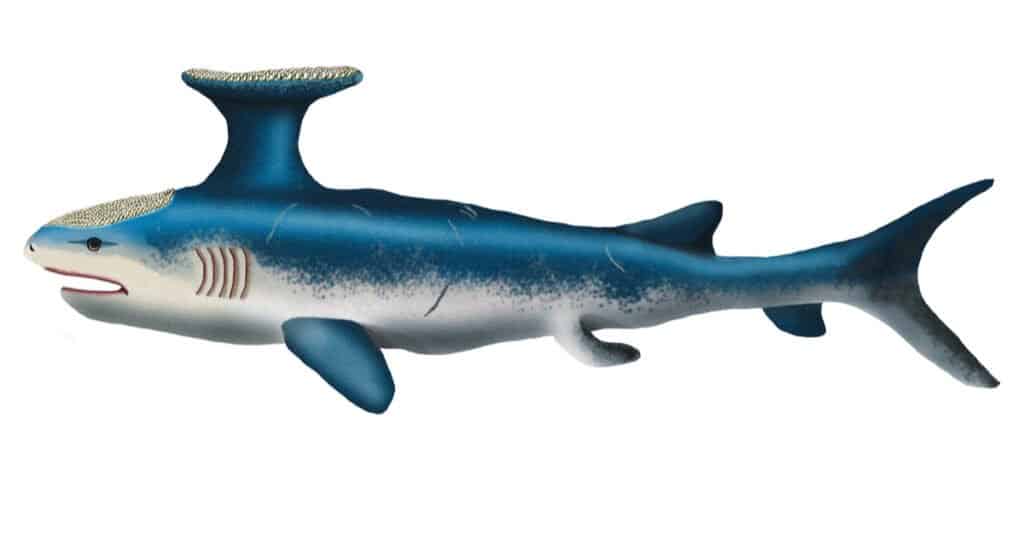
Stethancanthus is known as the “anvil shark” for obvious reasons!
©Zero Smany/Shutterstock.com
The Stethacanthus lived about 360 million to 340 million years ago, making it one of the very oldest sharks on this list! Often called the anvil shark, the Stethacanthus had an odd dorsal fin that it’s now known for.
We all know what the fin on a modern-day shark’s upper back looks like. A Stethacanthus’ dorsal fin is in the same location, yet it’s not pointed like a modern-day shark’s. Instead, it had a flat top that looks to be shaped like an anvil. On top of this flattened fin were enlarged denticles, which experts have been attempting to explain for a long time now.
While many theories suggest why this dorsal fin was shaped the way it is, the most common theory suggests that the fin has something to do with the mating between Stethacanthus, as only males seemed to have the anvil.
Other than this crazy feature, Stethacanthus didn’t get very big in length and were often much smaller than your average human today. This shark is also very ratshark-like!
7. Edestus
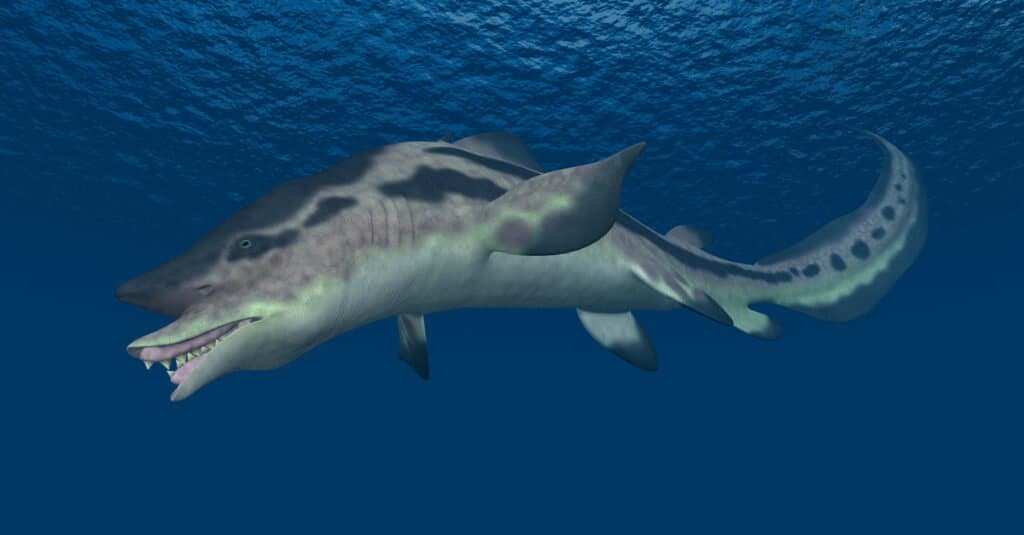
Edestus could grow to the same size as today’s great white sharks!
©Michael Rosskothen/Shutterstock.com
Having lived about 300 million to 320 million years ago, the Edestus is another prehistoric shark that looks quite… odd. Also called the scissor-toothed shark, the Edestus had curved jaws that resulted in its teeth sticking out at odd angles. While its appearance is crazy, it was a large shark that reached up to 22 feet in length (about the same size as the largest great white shark today)!
The most interesting thing about the Edestus is the way it used to hunt. Sharks all have interesting hunting methods, though we sometimes don’t get to know too much about how prehistoric sharks hunted their prey. That can’t be said about Edestus!
While some parts of their hunting do remain a mystery, it is thought that Edestus would thrash its head up and down and create wounds on its prey, something not seen in today’s sharks!
6. Xenacanthus
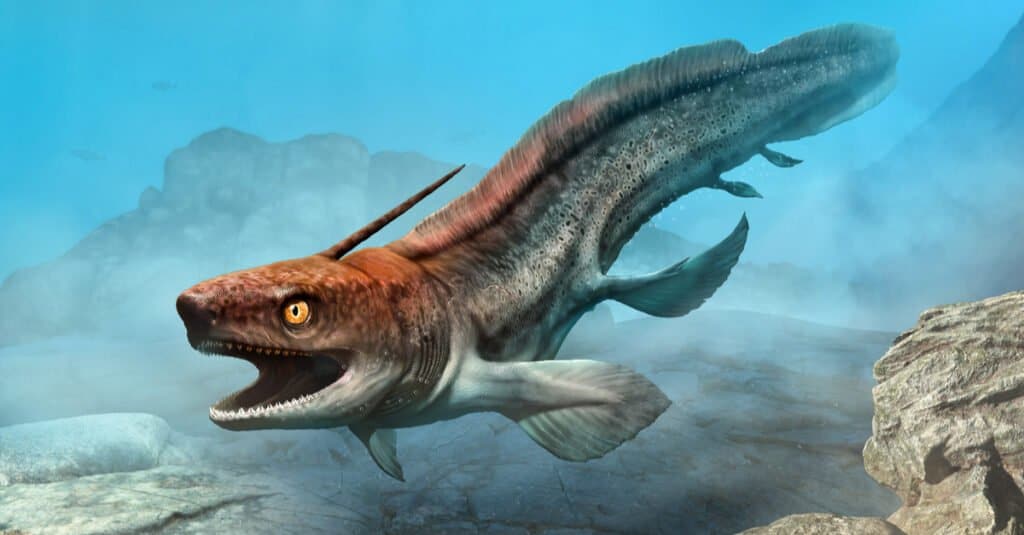
Xenacanthus is known as the “eel shark!”
©Warpaint/Shutterstock.com
Often called an eel shark, the Xenacanthus became extinct about 202 million years ago, making it another very old shark on this list. While it is a shark, the Xenacanthus definitely doesn’t look like one. Plus, this shark was a freshwater shark!
Because this shark was a freshwater shark, the Xenacanthus possibly thrived in waters such as swamps, allowing its eel-like body to beneficially help it navigate around. A larger, modern-looking type of shark definitely wouldn’t have thrived in these types of freshwaters.
Xenacanthus didn’t get too big and is mainly thought to only have grown to be about a meter in length. This shark also looked quite a lot like modern-day eels, hence its name.
The most interesting about this shark is its spine. The Xenacanthus had a sharp spine that possibly contained venom, making the shark act almost like a stingray can! This spine, therefore, is thought to have been the main form of protection against predators that often were much bigger than the Xenacanthus.
5. Ptychodus
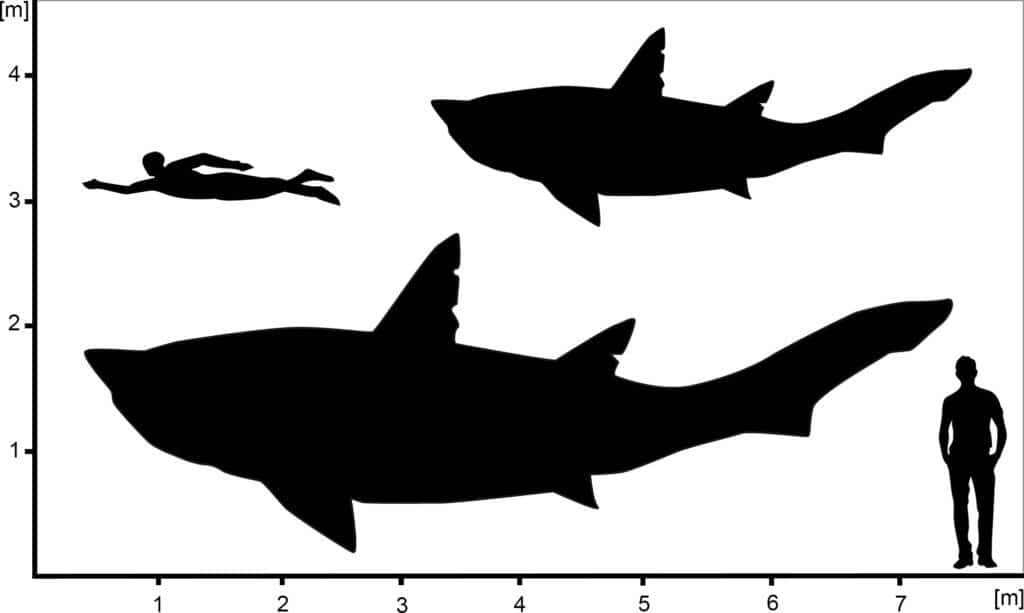
A comparison of the minimum (top) and maximum (bottom) size estimates of Ptychodus.
Image credit from PLOS ONE.
©Jambura PL, Kriwet J, CC BY 4.0, via Wikimedia Commons – License
Ptychodus was one of the largest prehistoric sharks, with some estimates placing its size up to 33 feet in length! Like today’s whale sharks it had a mouth full of teeth that were used to crush up its food. In comparison, Ptychodus had larger molars that would crush large shellfish instead of the plankton and krill today’s whale sharks eat. Ptychodus went extinct around 85 million years ago.
4. Cladoselache

Cladoselache lived 380 million years ago!
©Catmando/Shutterstock.com
Coined the first real shark, Cladoselache lived more than 380 million years ago. While considered a shark, a Cladoselache has more in common with your average fish than your average shark today. Much smaller and less muscular than sharks, Cladoselache had a longer and slimmer body that is more akin to what large fishes look like.
Cladoselache also didn’t have scales or any type of armor plates on its body, another very interesting appearance trait. During this time, the Cladoselache was not a major predator in the ocean, possibly because of its very fragile appearance. However, these sharks did manage to get away from apex predators by swimming very fast!
The Cladoselache, while so different from sharks today, is incredibly important to the evolution of sharks as a whole. Plus, the appearance of these sharks is so interesting – and odd!
3. Helicoprion
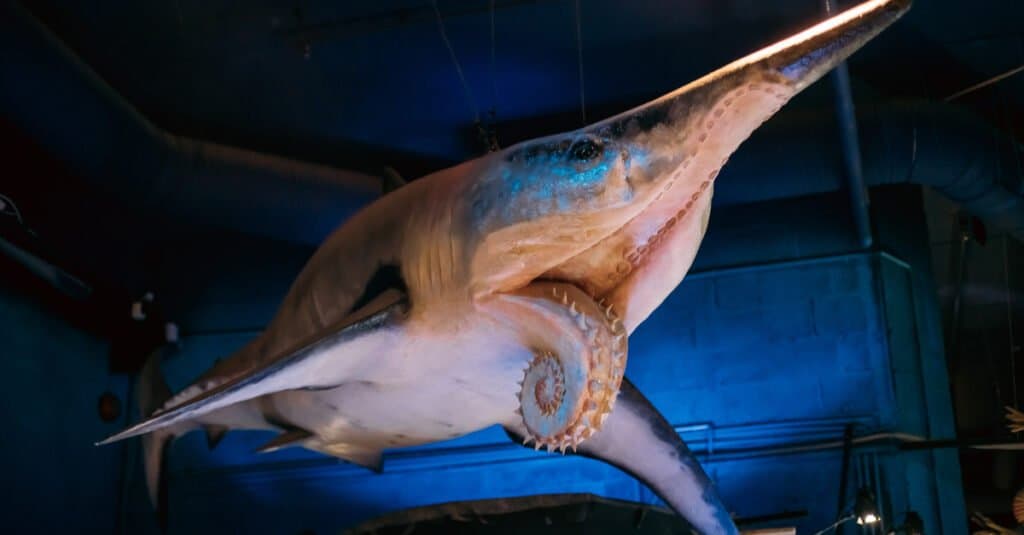
Helicoprion is known as the “buzzsaw” shark for good reason!
©Grisha Bruev/Shutterstock.com
Helicoprion, also called the “buzzsaw shark”, lived about 290 million to 250 million years ago. This prehistoric shark also happens to be one of the most interesting additions to this list. When the first Helicoprion fossil was founded, archeologists had no idea what they were looking at and initially thought they had found ammonite.
Eventually, it was discovered that this odd whorl of patterns was actually teeth. The Helicoprion had a curled-up jawbone of teeth that rounded and protruded from the lower half of its jaw. It is thought that Helicoprions were the first sharks to regrow their teeth after losing them – something modern sharks today must do to survive – therefore making this shark an excellent example of the evolution of sharks.
Helicoprions were formidable sharks, especially as no shark previous to them could regrow their own teeth. These sharks also managed to live about 40 million years and survive the Great Permian Extinction, which killed 90 – 95% of all living things on Earth and is thought to be the worst mass extinction in the Earth’s entire history!
2. Bluntnose Sixgill Shark
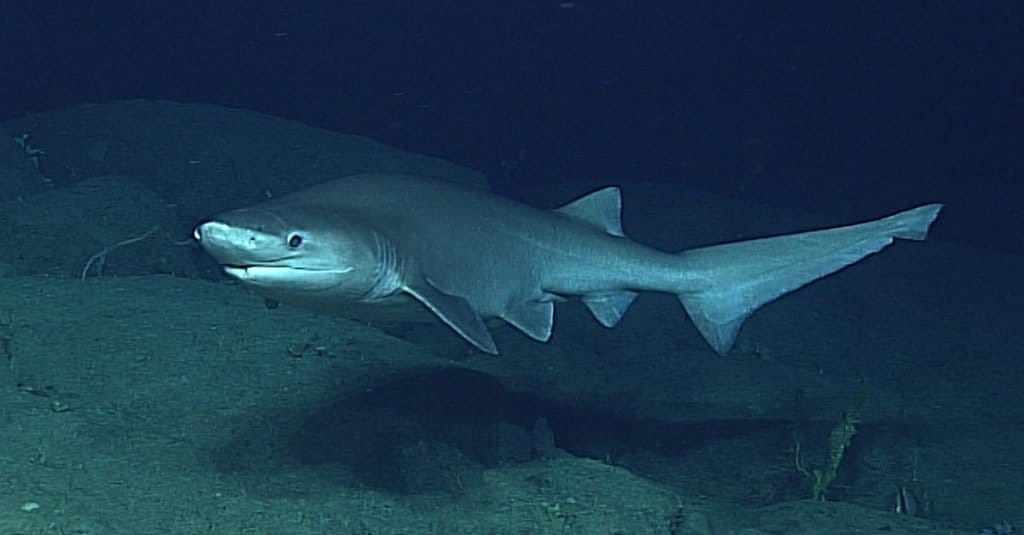
Sixgill shark
(Hexanchus griseus) was seen while exploring Santa Rosa Reef, south of Guam, during the first dive of the Deepwater Exploration of the Marianas expedition.
©NOAA Ocean Explorer from USA / CC BY-SA 2.0 – License
Here’s something different on this list, a shark that’s not even extinct! The bluntnose sixgill shark can trace its lineage back to the Jurassic era when dinosaurs roamed the Earth. This type of shark can grow up to 20 feet in length, about the same length as a great white shark, yet it’s rarely observed thanks to its deepwater habitat.
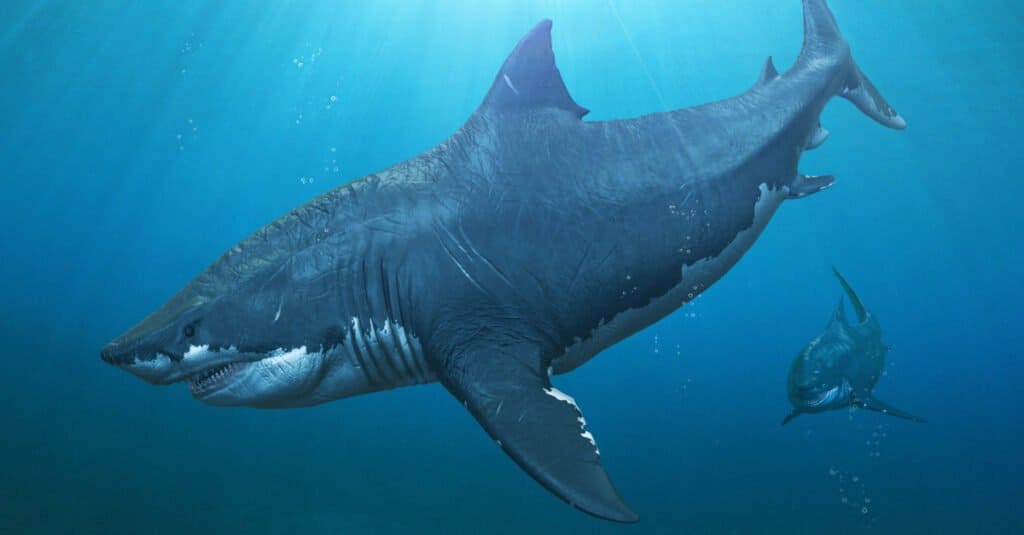
Megalodons could grow to sizes that have been estimated past 50 feet
©Herschel Hoffmeyer/Shutterstock.com
1. Megalodon
No list of prehistoric sharks is complete without including the megalodon. Thought to be the largest fish and shark to ever live, megalodons were huge prehistoric sharks that were apex predators during their time. These giants lived from 23 million to 2.6 million years ago and ate large fish – such as whales and other large sharks – like it was no issue.
Megalodons are possibly the most well-known creature on this list, just because they are such fascinating animals. The only fossils we have to understand these sharks are their teeth – which tend to run about three sizes larger than your average modern white shark’s tooth.
Through their fossilized teeth, experts were able to determine just how large this giant shark was. These sharks were thriving throughout the world back when they were alive, as their teeth have been found on every single continent, save Antarctica.
Megalodons were apex predators during their time. Even the rivals they had couldn’t compare to them. However, climate change brought cold weather and water temperatures, resulting in megalodons slowly dying out, as they only thrive in warm water. Plus, it is thought that they also lost a lot of their prey during this change. However, megalodons are still known as one of the most – if not the most – interesting prehistoric sharks!
Summary Of The 10 Prehistoric Sharks
| Rank | Shark | Date Roamed The Earth |
|---|---|---|
| 1. | Megalodon | lived 23 million to 2.6 million years ago |
| 2. | Bluntnose Sixgill Shark | Still alive! |
| 3. | Helicoprion | lived about 290 million to 250 million years ago |
| 4. | Cladoselache | lived more than 380 million years ago |
| 5. | Ptychodus | extinct around 85 million years ago |
| 6. | Xenacanthus | became extinct about 202 million years ago |
| 7. | Edestus | lived about 300 million to 320 million years ago |
| 8. | Stethacanthus | lived about 360 million to 340 million years ago |
| 9. | Cretoxyrhina | lived about 100 million to 75 million years ago |
| 10. | Hybodus | lived about 303.4 million to 66 million years ago |
The photo featured at the top of this post is © Grisha Bruev/Shutterstock.com
Thank you for reading! Have some feedback for us? Contact the AZ Animals editorial team.






